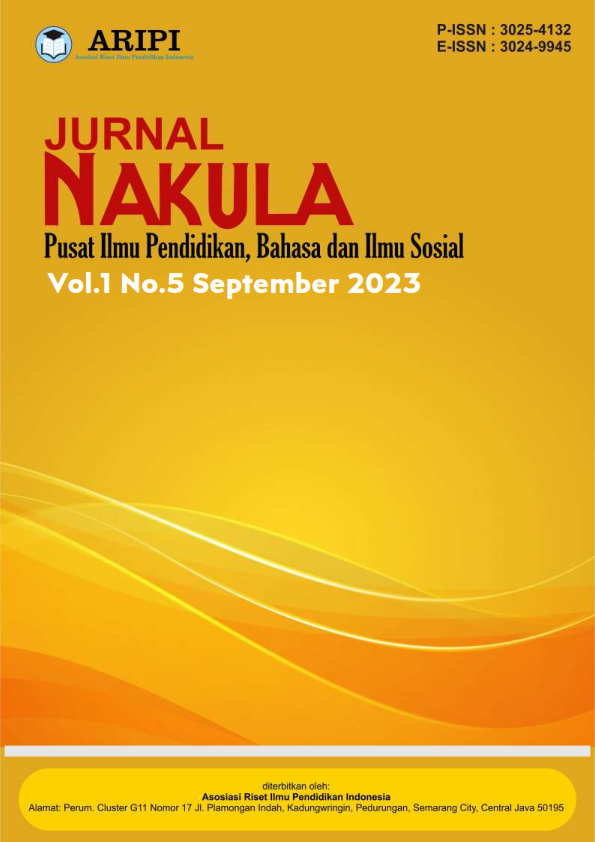Evaluasi Kebijakan Program SP3OR Jawa Barat
DOI:
https://doi.org/10.61132/nakula.v1i5.212Keywords:
Policy, SP3OR, West Java.Abstract
This paper starts from the activities carried out labour in several periods SP3OR West Java programs undertaken by the government of West Java. It can be seen from the population in some districts in community sports activities. This study aimed to evaluate the extent to which the results and benefits of the program in the district of West Java SP3OR to cultivate and increase the number of Public Participation in sports. This study used descriptive qualitative method, as well as with research subjects labour, SP3OR and districts of Youth and Sports Department of West Java Province. Techniques of data retrieval by means of literature study and field study consisted of observations and interviews triangulation. Triangulation is done to society (the beneficiaries), Electric SP3OR and youth and Sports Department of West Java. These results indicate SP3OR program evaluation that describes the results of the program, the work done in the program, the program's ability to solve the problem of the sport, the distribution of the program at the district level and benefits program for people in the district SP3OR.
Downloads
References
Ahmadian, M., Roshan, V. D., & Leicht, A. S. (2018). Age-related effect of aerobic exercise training on antioxidant and oxidative markers in the liver challenged by doxorubicin in rats. Free Radical Research, 0(0), 1–8. https://doi.org/10.1080/10715762.2018.1470328
Aksu, N. T. (2018). Effects of progressive muscle relaxation training on sleep and quality of life in patients with pulmonary resection, 695–702.
Article, O. (2014). Jamal. F Kalkhoran 1 , Amir Shariati 2 1, 5(2), 75–84.
Bacchi, C. (2009). Analysing policy: what’s the problem represented to be? Pearson Australia: Frenchs Forest.
Birch, J. E., & Birch, J. E. (2015). The Inner Game of Sport : is Everything in the THE INNER GAME OF SPORT : IS EVERYTHING IN THE BRAIN ?, 1321(October). https://doi.org/10.1080/17511320903496493
Bruner, M. W., Hall, J., & Côté, J. (2011). Influence of sport type and interdependence on the developmental experiences of youth male athletes. European Journal of Sport Science, 11(2), 131–142. https://doi.org/10.1080/17461391.2010.499969
Chalip, L. (2006). Toward a Distinctive, (1), 1–21.
Chockalingam, N., Thomas, N. B., Duval, L., Chockalingam, N., Thomas, N. B., & Duval, L. (2012). Prosthetics and Orthotics International. https://doi.org/10.1177/0309364612447096
Coalter, F. (2007). A wider social role for sport: who’s keeping the score? London: Routledge.
Corrêa, U. C., Pinho, S. T. De, Letícia, S., Clavijo, A. R., Souza, T. D. O., Tani, G., … Clavijo, R. (2016). Revealing the decision-making of dribbling in the sport of futsal Revealing the decision-making of dribbling in the sport of futsal. Journal of Sports Sciences, 00(00), 1–8. https://doi.org/10.1080/02640414.2016.1232488
Cremades, J. G., Flournoy, B., & Gomez, C. B. (2012). Scholarship Status and Gender Differences in Motivation among U . S . Collegiate Track and Field Athletes, 7(2), 333–344.
Darhl, M. (2002). Intrinsic-extrinsic factors in sport motivation ’, 459–476.
De Oliveira Bueno, M. J., Caetano, F. G., Pereira, T. J. C., De Souza, N. M., Moreira, G. D., Nakamura, F. Y., … Moura, F. A. (2014). Analysis of the distance covered by Brazilian professional futsal players during official matches. Sports Biomechanics / International Society of Biomechanics in Sports, 13(3), 230–240. https://doi.org/10.1080/14763141.2014.958872
Firmansyah, H. (2009). HUBUNGAN MOTIVASI BERPRESTASI SISWA DENGAN, 6(April), 30–33.
Giuffrida, C. L. G., Shea, J. B., & Fairbrother, J. T. (2002). Differential transfer benefits of increased practice for constant, blocked, and serial practice schedules. Journal of Motor Behavior, 34(4), 353–365. https://doi.org/10.1080/00222890209601953
Guedes, D. P., & Netto, J. E. S. (2013). Sport participation motives of young brazilian athletes 1, 742–759. https://doi.org/10.2466/06.30.PMS.117x33z2
Leidl, D. (2009). Motivation in Sport : Bridging Historical and Contemporary Theory Through a Qualitative Approach, 4(2), 155–175.
Lupo, A. C., Ungureanu, A. N., Varalda, M., & Brustio, P. R. (2019). Running technique is more effective than soccer-specific training for improving the sprint and agility performances with ball possession of prepubescent soccer players, 249–255.
Naser, N., & Ali, A. (2016). A descriptive-comparative study of performance characteristics in futsal players of different levels. Journal of Sports Sciences, 0414(January), 1–9. https://doi.org/10.1080/02640414.2015.1134806
Nicholson, M., Hoye, R., and Houlihan, B. (2011). Participation in sport: international policy perspectives. Oxon: Routledge.
Nunez, J. L., Martin-albo, J., & Navarro, J. G. (2006). O F THE SPORT MOTIVATION SCALE ’, 919–930.
Parsons, W. (2001). PUBLIC POLICY Pengantar Teori dan Praktik Analisis Kebijakan. Jakarta: Kencana Prenada Media Group.
Prieto, J. A., González, V., Valle, M. Del, Nistal, P., Prieto, J. A., González, V., … Nistal, P. (2016). The Influence of Age on Aerobic Capacity and Health Indicators of Three Rescue Groups The Influence of Age on Aerobic Capacity and Health Indicators of Three Rescue Groups, 3548(March). https://doi.org/10.1080/10803548.2013.11076963
Reiss, S. (2012). Intrinsic and Extrinsic Motivation, 39(2), 152–156. https://doi.org/10.1177/0098628312437704
Relationship, E. T. H. E., Recreational, B., & Participation, S. (2006). MOTIVATION AND AMOTIVATION ’, 363–374.
Rose, N., & Miller, P. (2010). Political power beyond the State: problematics of government. 1992. The British Journal of Sociology, 61 Suppl 1(2), 271–303. https://doi.org/10.1111/j.1468-4446.2009.01247.x
Sassi, R. H. (2019). Sedentary behavior and physical activity classification using accelerometer cut points in 9 — 11-year-old children Classification du comportement sédentaire et des activités. Science & Sports, 34(1), 30–39. https://doi.org/10.1016/j.scispo.2018.04.013
State, E. (2012). Information Development. https://doi.org/10.1177/0266666912438567
Tanaka, K., Rogers, L. S., Vanness, J. M., Musselman, R., & Jensen, C. D. (2018). The Influence of Different Walking Conditions on Walking Parameters June 2 8 : 00 AM - 9 : 30 AM Physiological Performance Predictions Based on Simple Assessments June 2 8 : 00 AM - 9 : 30 AM Relationship Between Clock Gene Expression , MEQ Score , and Exercise Performance June 2 8 : 00 AM - 9 : 30 AM Changes in Blood pH and Ammonia Following Repeat Sprint Performance Greggory R . Davis , Jordan Perett , Danielle Rudesill , David Bellar . University of Louisiana at Lafayette , Lafayette , LA . Copyright © 2018 by the American College of Sports Medicine . Unauthorized reproduction of this article is prohibited ., 3218.
Wang, C. K. J., Liu, W. C., Nogawa, H., & Sun, Y. (2015). The influence of Japanese sporting culture and motivation on sport participation and life aspirations. Asia Pacific Journal of Sport and Social Science, 4(2), 113–123. https://doi.org/10.1080/21640599.2015.1065567
Yadolahzadeh, A. (2020). The role of mental imagery and stress management training in the performance of female swimmers. ATENA JOURNAL OF SPORTS SCIENCES, 3, 1–11.
Yeh, S., Guo, K., Ou, C., & Kao, C. (2011). Prediction of intrinsic motivation and sports performance using 2 × 2 achievement goal framework 1, 625–637. https://doi.org/10.2466/05.11.14.PR0.108.2.625-637
Downloads
Published
How to Cite
Issue
Section
License
Copyright (c) 2023 Jurnal Nakula : Pusat Ilmu Pendidikan, Bahasa dan Ilmu Sosial

This work is licensed under a Creative Commons Attribution-ShareAlike 4.0 International License.





